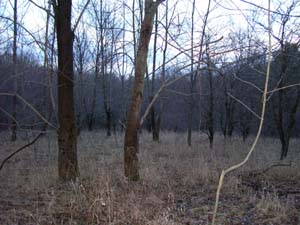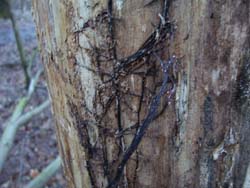Deer Run Trail
Metro Parks, Serving Summit CountyO'Neil Woods Metropark
Trail Location
Bath, Ohio (Summit County)
Follow Akron-Peninsula Road to Ira Road. Take Ira Road West. After the road crosses the Cuyahoga Valley Scenic Railroad, Martin Road will be on the left. Take Martin Road to O'Neil Woods MetroPark, which will be on the left at a curve on Martin Road.
Trail Summary
Length: 1.8 mile.
Duration: two hours
Surface: natural
Type: Loop.
Difficulty: moderate
Accessibility:steep slopes, uneven surface, stairs, muddy in wet weather.
Trail Description
This hiking trail is narrow and very rustic. From the picnic area at the Martin Road parking lot, the trail begins just past the restrooms and goes up a slight hill. As you hike up the hill, you will see that the foreest is quite young, with many small, light-loving trees gowing along the trail. These many hawthorns, intermixed with multiflora rose, young white ash, and maples are growing among a field of grasses that would have, perhaps thrity to forty years ago, been a pasture or hay-field. As you look to the left of the trail here and there you will notice rocks in the soil. Had this field been used for row crops such as corn, these rocks would have been long ago removed to protect the plows from damage.

A young forest springing up in an old pasture along the Deer Run Trail.
Near the top of the hill, the old field is still very visible, despite being invaded by a number of moderately sized trees, maples and ashes mostly, seeking to reclaim their ancestral homes from the brief period of human disturbance. Perhaps because of the past disturbance,this area also offers a good chance of seeing Ruffed Grouse, Woodcock, and Eastern Bluebird.
As you pass this fairly open area, the trail descends and you will notice larger trees become more frequent. This older woods will lead to a high ridge over-looking Yellow Creek and the Cuyahoga River. Beautiful views abound when the leaves are off. During the summer when the leaves obscure the view, you can still get a glimpse here and there of the valley beyond, but the woods take on a more closed aspect, making you feel as though nothing could disturb the peace of this place, isolated from the hustle-bustle of daily life.

A dead tree showing signs of Shoestring Root Rot.
But alas, even here, the peaceful scene does not hold up under scrutiny. You will see small patches where many trees are dead or dying. If you look closesly at some of the dead trees standing near the trail, you may see some black or chestnut brown strings clasping the trunk where the bark used to be. This is a sign that Shoestring Root Rot has infested the woods. This fungus, Armillaria spp., lives under ground, and sends its strings up into trees, killing patches of forest here and there. In the summer, you may sometimes smell a citrus smell in the forest. If you do, take a look around and see if you can find some trees dead or dying from shoestring root rot.
Such disturbances are part of the natural cycle of life in a forest, and over time, these small patches of change create a mosaic of diverse plant communties with an intersting mixture of different species. When trees die, it lets light into a forest, which in turn can stimulate the growth of trees and flowers that need more light than had been available before the larger trees dies. Generally if you see one or two light loving trees in a forest, such as black cherry trees, which dot the forest along the Deer Run Trail, it means that at some time in the past, a disturbance of some sort let enough light in for the trees to thrive and grow into the canopy. The more diverse a forest is, having a good mixture of different types of plants, the less susceptible the forest will be to diseases, insect damage, and other stresses.
Another important role that fungi, such as Shoestring Root Rot, play is that the killed trees are decomposed by the fungi and microorganisms, as well as becoming habitat and food sources for birds and other forest animals. natural death of trees is an integral part of the food web, and contributes to the great number of birds, mammals, reptiles and amphibians we may find in the parks.
As the trail continues, you will cross Bath Road, and walk for a good distance along Yellow Creek, which is one of the cleanest tributaries of the Cuyahoga River. If you are lucky, in the stream corridor you may hear the ratchet-like calls of the belted kingfisher, or even see one perched in a branch above Yellow Creek. The older woods along the trail also offer moderate amounts of large dead and downed trees, a great place to see the Pileated Woodpecker.
Soon the trail will cross bath road again, and you will ascend through some nice mixed decisduous forests. Shortly, your peaceful trip through O'Neil Woods along the Deer Run Trail will come to an end, back where you started.
Nearby Trails
Buckeye Trail
Ohio and Erie Canal Towpath Trail (CVNP Section)
